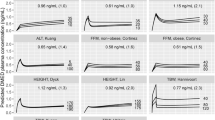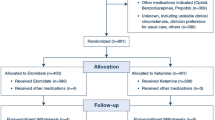Abstract
The PhysioDoloris™ analgesia monitor assesses nociception effects on the autonomic nervous system by analyzing changes in heart rate variability (HRV). This non-invasive device analyses ECG signals and determines the analgesia nociception index (ANI), allowing for quantitative assessment of the analgesia/nociception balance in anesthetized patients. Ketamine, an analgesic adjuvant with sympathomimetic properties, has been shown to improve perioperative pain management. The purpose of this pilot study was to evaluate whether low-dose ketamine, due to its intrinsic effect on the sino-atrial node, affects HRV and, therefore, interferes with ANI measurements. This pilot study included 20 women undergoing abdominal hysterectomies. Anesthesia and analgesia were maintained with sevoflurane and fentanyl respectively, in a standardized manner. Five minutes after intubation, 0.5 μg kg−1 of intravenous (i.v.) ketamine was administered. ANI, bispectral index (BIS), heart rate and blood pressure were recorded from the induction of anesthesia until 5 min after skin incision. There was not any significant decrease in mean (±SD) ANI values after intubation (2.11 ± 20.11, p = 0.35) or i.v. ketamine administration (1.31 ± 15.26, p = 0.28). The mean (±SD) reduction in ANI values after skin incision was statistically significant (13.65 ± 15.44, p = 0.01), which is consistent with increased nociception. A single i.v. bolus of 0.5 μg kg−1 ketamine did not influence the ANI values of 20 women under standardized general anesthesia conditions and absent noxious stimulation. These results suggest that the ANI derived from the PhysioDoloris™ analgesia monitor is feasible under such clinical conditions.

Similar content being viewed by others
References
Logier R, Jeanne M, De Jonckheere J, Dassonneville A, Delecroix M, Tavernier B. PhysioDoloris: a monitoring device for analgesia/nociception balance evaluation using heart rate variability analysis. Conf Proc IEEE Eng Med Biol Soc. 2010;2010:1194–7.
Jeanne M, Logier R, De Jonckheere J, Tavernier B. Heart rate variability during total intravenous anesthesia: effects of nociception and analgesia. Auton Neurosci. 2009;147:91–6.
Paris A, Tonner PH, Bein B, von Knobelsdorff G, Scholz J. [Heart rate variability in anesthesia]. Anaesthesiol Reanim. 2001;26:60–9.
Jeanne M, Logier R, De Jonckheere J, Tavernier B. Validation of a graphic measurement of heart rate variability to assess analgesia/nociception balance during general anesthesia. Conf Proc IEEE Eng Med Biol Soc. 2009;2009:1840–3.
Le Guen M, Jeanne M, Sievert K, Al Moubarik M, Chazot T, Laloe PA, Dreyfus JF, Fischler M. The Analgesia Nociception Index: a pilot study to evaluation of a new pain parameter during labor. Int J Obstet Anesth. 2012;21:146–51.
Logier R, Jeanne M, Tavernier B, De Jonckheere J. Pain/analgesia evaluation using heart rate variability analysis. Conf Proc IEEE Eng Med Biol Soc. 2006;1:4303–6.
Logier R, Jeanne M, Tavernier B. Method and device for assessing pain in human being - European patent No 04370029.3, University Hospital of Lille, University of Lille II, 20/09/2004.
Treister R, Kliger M, Zuckerman G, Aryeh IG, Eisenberg E. Differentiating between heat pain intensities: the combined effect of multiple autonomic parameters. Pain. 2012;153:1807–14.
Appelhans BM, Luecken LJ. Heart rate variability and pain: associations of two interrelated homeostatic processes. Biol Psychol. 2008;77:174–82.
Himmelseher S, Durieux ME. Ketamine for perioperative pain management. Anesthesiology. 2005;102:211–20.
Laskowski K, Stirling A, McKay WP, Lim HJ. A systematic review of intravenous ketamine for postoperative analgesia. Can J Anaesth. 2011;58:911–23.
Joly V, Richebe P, Guignard B, Fletcher D, Maurette P, Sessler DI, Chauvin M. Remifentanil-induced postoperative hyperalgesia and its prevention with small-dose ketamine. Anesthesiology. 2005;103:147–55.
Chernow B, Lake CR, Cruess D, Coyle J, Hughes P, Balestrieri F, Casey L, Rainey TG, Fletcher JR. Plasma, urine, and CSF catecholamine concentrations during and after ketamine anesthesia. Crit Care Med. 1982;10:600–3.
Weinbroum AA. Non-opioid IV adjuvants in the perioperative period: pharmacological and clinical aspects of ketamine and gabapentinoids. Pharmacol Res. 2012;65:411–29.
Hans P, Dewandre PY, Brichant JF, Bonhomme V. Comparative effects of ketamine on Bispectral Index and spectral entropy of the electroencephalogram under sevoflurane anaesthesia. Br J Anaesth. 2005;94:336–40.
Bowdle TA. Depth of anesthesia monitoring. Anesthesiol Clin. 2006;24:793–822.
Sabourdin N, Arnaout M, Louvet N, Guye ML, Piana F, Constant I. Pain monitoring in anesthetized children: first assessment of skin conductance and analgesia-nociception index at different infusion rates of remifentanil. Paediatr Anaesth. 2013;23:149–55.
Gruenewald M, Ilies C, Herz J, Schoenherr T, Fudickar A, Hocker J, Bein B. Influence of nociceptive stimulation on analgesia nociception index (ANI) during propofol-remifentanil anaesthesia. Br J Anaesth. 2013;110:1024–30.
Jeanne M, Clement C, De Jonckheere J, Logier R, Tavernier B. Variations of the analgesia nociception index during general anaesthesia for laparoscopic abdominal surgery. J Clin Monit Comput. 2012;26:289–94.
Acknowledgments
We would like to thank Katrina Golub, M.P.H. and Charles Spiekermann, PhD for their statistical support and Dr. T. A. Bowdle for critically reviewing the manuscript. This work was supported solely by departmental sources.
Conflict of interest
The authors declare that they have no conflict of interest.
Ethical standards
The investigation was conducted in accordance with the Declaration of Helsinki and Good Clinical Practice. This study was approved by the local ethical committee on the18th of April 2012 (Human Subjects Division, University of Washington, Seattle, USA. Chairperson: K Korslund, Ph.D. Approval # 42398).
Author information
Authors and Affiliations
Corresponding author
Additional information
Trial registry number: ClinicalTrials.gov record ID: NCT0171752.
Rights and permissions
About this article
Cite this article
Bollag, L., Ortner, C.M., Jelacic, S. et al. The effects of low-dose ketamine on the analgesia nociception index (ANI) measured with the novel PhysioDoloris™ analgesia monitor: a pilot study. J Clin Monit Comput 29, 291–295 (2015). https://doi.org/10.1007/s10877-014-9600-8
Received:
Accepted:
Published:
Issue Date:
DOI: https://doi.org/10.1007/s10877-014-9600-8




